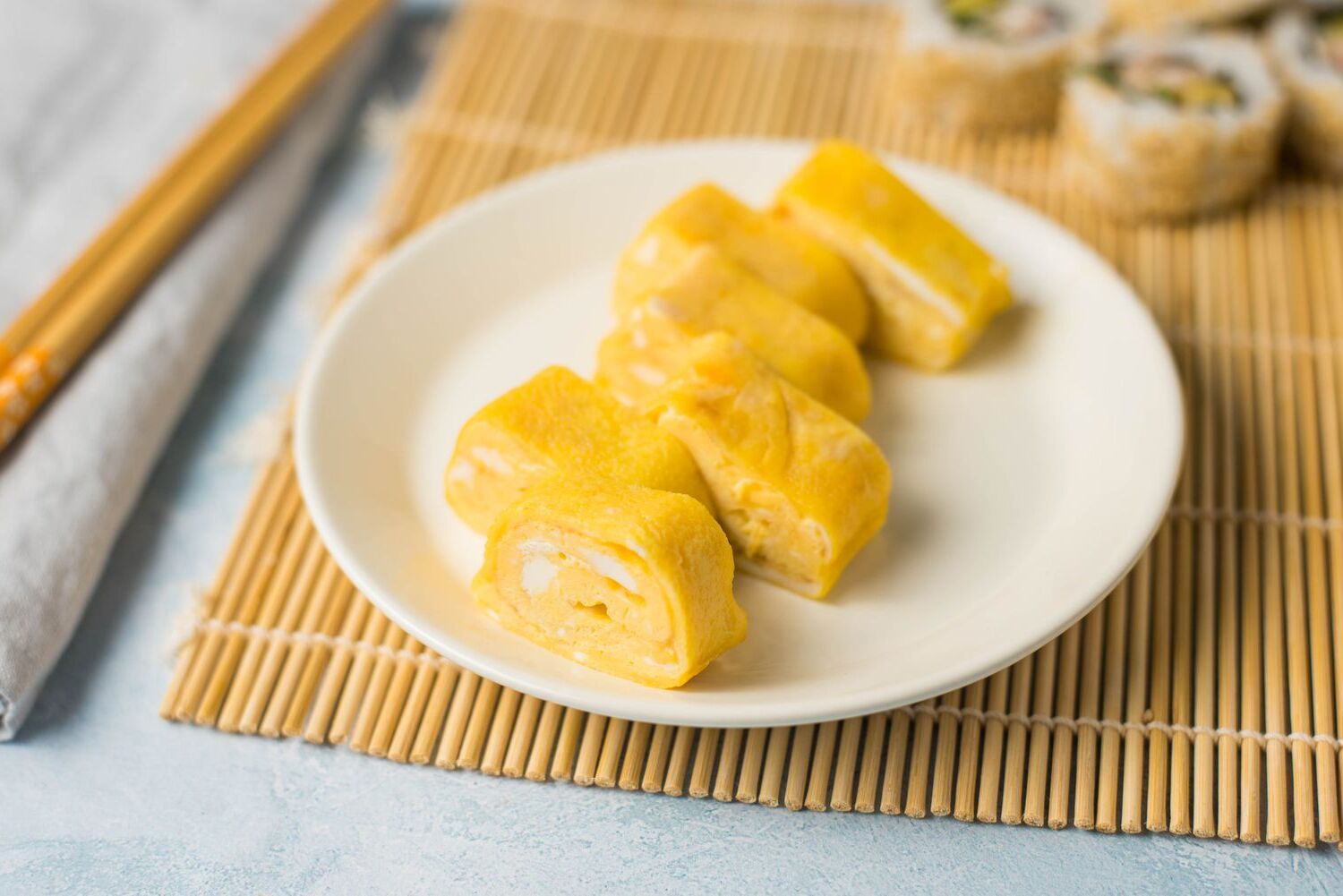Tamagoyaki, a Japanese rolled omelette, is a delightful dish that combines simplicity with elegance. This savory-sweet treat is often enjoyed as part of a traditional Japanese breakfast or as a component of sushi. Its delicate layers and balanced flavors make it a favorite among both children and adults.
Some ingredients in this recipe might not be commonly found in every household. Dashi stock is a Japanese cooking staple made from dried fish and seaweed, providing a unique umami flavor. Mirin is a sweet rice wine used in Japanese cuisine, adding a subtle sweetness and depth to the dish. These items can usually be found in the international or Asian section of your local supermarket.

Ingredients For Japanese Rolled Omelette (Tamagoyaki)
Eggs: The main ingredient, providing the base for the omelette.
Dashi stock: A Japanese soup stock made from dried fish and seaweed, adding umami flavor.
Soy sauce: A salty and savory condiment that enhances the flavor.
Mirin: A sweet rice wine that adds sweetness and depth.
Sugar: Adds a touch of sweetness to balance the flavors.
Vegetable oil: Used for cooking the omelette, preventing it from sticking to the pan.
Technique Tip for This Recipe
When making tamagoyaki, ensure that the egg mixture is whisked thoroughly to achieve a uniform consistency. This helps in creating smooth, even layers. Use a tamagoyaki pan for best results, as its rectangular shape allows for easier rolling. Keep the heat at medium to prevent the eggs from browning too quickly. If you notice the egg sticking, lightly reapply vegetable oil before adding the next layer.
Suggested Side Dishes
Alternative Ingredients
eggs - Substitute with egg whites: If you want a lower cholesterol option, you can use egg whites instead of whole eggs. Use about 8 egg whites to replace 4 whole eggs.
dashi stock - Substitute with chicken broth: If you don't have dashi stock, chicken broth can be used as a substitute. It provides a savory flavor, though it won't have the same umami depth as dashi.
soy sauce - Substitute with tamari: Tamari is a gluten-free alternative to soy sauce and has a similar flavor profile. It can be used in the same quantity.
mirin - Substitute with dry sherry: Dry sherry can be used as a substitute for mirin. It has a similar sweetness and acidity, though you might want to add a pinch of sugar to match the sweetness of mirin.
sugar - Substitute with honey: Honey can be used as a natural sweetener in place of sugar. Use slightly less honey than the amount of sugar called for, as honey is sweeter.
vegetable oil - Substitute with canola oil: Canola oil is a good substitute for vegetable oil. It has a neutral flavor and a similar smoke point, making it suitable for cooking.
Other Alternative Recipes Similar to This Dish
How to Store or Freeze This Dish
- Allow the tamagoyaki to cool completely before storing. This helps prevent condensation, which can make the omelette soggy.
- Wrap the tamagoyaki tightly in plastic wrap or place it in an airtight container. This will keep it fresh and prevent it from absorbing other odors in the refrigerator.
- Store the wrapped tamagoyaki in the refrigerator for up to 3 days. For best results, consume it within this time frame to enjoy its optimal flavor and texture.
- If you plan to freeze the tamagoyaki, cut it into individual portions first. This makes it easier to thaw and reheat only the amount you need.
- Wrap each portion of tamagoyaki in plastic wrap, then place the wrapped pieces in a freezer-safe bag or container. This double layer of protection helps prevent freezer burn.
- Label the bag or container with the date to keep track of how long the tamagoyaki has been stored. Frozen tamagoyaki can be kept for up to 1 month.
- To thaw, transfer the desired portions of tamagoyaki from the freezer to the refrigerator and let them thaw overnight. This gradual thawing helps maintain the texture.
- Reheat the thawed tamagoyaki in a microwave or a non-stick pan over low heat until warmed through. Avoid overheating, as this can make the omelette rubbery.
- Enjoy the reheated tamagoyaki as a quick breakfast, a side dish, or a tasty addition to your bento box.
How to Reheat Leftovers
Microwave Method:
- Place the tamagoyaki slices on a microwave-safe plate.
- Cover with a damp paper towel to retain moisture.
- Heat on medium power for 20-30 seconds. Check if warm; if not, continue in 10-second intervals.
Stovetop Method:
- Heat a non-stick skillet over low heat.
- Lightly oil the pan with vegetable oil.
- Place the tamagoyaki slices in the pan and cover with a lid.
- Heat for 1-2 minutes on each side until warmed through.
Oven Method:
- Preheat the oven to 300°F (150°C).
- Place the tamagoyaki slices on a baking sheet lined with parchment paper.
- Cover the slices with aluminum foil to prevent drying out.
- Heat for 10-15 minutes or until warm.
Steaming Method:
- Set up a steamer pot with water and bring to a simmer.
- Place the tamagoyaki slices on a heatproof plate.
- Steam for 3-5 minutes until heated through.
Air Fryer Method:
- Preheat the air fryer to 300°F (150°C).
- Place the tamagoyaki slices in the air fryer basket.
- Heat for 3-5 minutes, checking halfway to ensure they don’t overcook.
Best Tools for Making This Recipe
Mixing bowl: A container used to whisk together the eggs, dashi stock, soy sauce, mirin, and sugar until well combined.
Whisk: A utensil used to blend the egg mixture smoothly.
Tamagoyaki pan: A rectangular or square pan specifically designed for making Japanese rolled omelettes.
Vegetable oil: Used to lightly oil the pan to prevent the egg from sticking.
Chopsticks: Traditional Japanese utensils used to roll the egg layer towards you.
Spatula: An alternative tool to chopsticks for rolling the egg layer.
Knife: Used to slice the rolled omelette into pieces.
Cutting board: A surface on which to slice the rolled omelette.
Plate: Used to serve the sliced omelette.
How to Save Time on Making This Dish
Prepare ingredients in advance: Measure and mix the dashi stock, soy sauce, mirin, and sugar with the eggs ahead of time to streamline the cooking process.
Use a non-stick pan: A non-stick tamagoyaki pan reduces the need for excessive oil and makes rolling the omelette easier.
Preheat the pan: Ensure the pan is properly heated before adding the egg mixture to cook each layer evenly and quickly.
Consistent layers: Pour the same amount of egg mixture for each layer to maintain uniformity and speed up cooking.

Japanese Rolled Omelette (Tamagoyaki)
Ingredients
Main Ingredients
- 4 eggs
- 2 tablespoon dashi stock
- 1 tablespoon soy sauce
- 1 tablespoon mirin
- 1 teaspoon sugar
- 1 teaspoon vegetable oil for cooking
Instructions
- 1. In a mixing bowl, whisk together the eggs, dashi stock, soy sauce, mirin, and sugar until well combined.
- 2. Heat the tamagoyaki pan over medium heat and lightly oil it with vegetable oil.
- 3. Pour a thin layer of the egg mixture into the pan, tilting to cover the bottom. Cook until the egg is set but still slightly soft on top.
- 4. Roll the egg layer towards you using chopsticks or a spatula. Move the rolled egg to the far side of the pan.
- 5. Add more oil if needed, then pour another thin layer of the egg mixture into the pan. Lift the rolled egg to let the uncooked egg flow underneath.
- 6. When the new layer is set, roll the egg towards you again. Repeat the process until all the egg mixture is used.
- 7. Remove the rolled omelette from the pan and let it cool slightly. Slice into pieces and serve warm or at room temperature.
Nutritional Value
Keywords
More Amazing Recipes to Try 🙂
- Japanese Basque Cheesecake Recipe1 Hours 5 Minutes
- Japanese Banana Bread Recipe1 Hours 5 Minutes
- Japanese Fish Head Soup Recipe45 Minutes
- Japanese Chestnut Recipe1 Hours
- Japanese Congee (Okayu) Recipe35 Minutes
- Japanese Shrimp Tempura Recipe25 Minutes
- Japanese Crispy Pork Belly Recipe1 Hours 50 Minutes
- Japanese Soft Boiled Egg Recipe12 Minutes

Leave a Reply